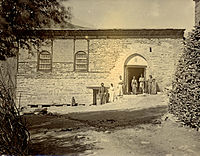Assyrian Church
|
Holy Apostolic Catholic Assyrian Church of the East |
|
|---|---|
| ܥܕܬܐ ܕܡܕܢܚܐ ܕܐܬܘܖ̈ܝܐ | |

|
|
| Abbreviation | ACOE |
| Classification | Eastern Christian |
| Orientation | Syriac Christian |
| Head | Patriarch Gewargis III |
| Region | Middle East; diaspora |
| Language | Syriac,Aramaic |
| Liturgy | East Syrian Rite |
| Headquarters | Ankawa, Erbil, Iraq |
| Founder |
Patriarch Shimun XIII Dinkha Traces apostolic succession to Thomas the Apostle, and Bartholomew the Apostle through the Church of the East, according to its tradition |
| Origin | 1692 Konak, Ottoman Empire |
| Separated from | Church of Assyria and Mosul (1692) |
| Separations | Ancient Church of the East (1968) |
| Members | 170,000 |
| Official website | Official website |
The Assyrian Church of the East (Syriac: ܥܕܬܐ ܕܡܕܢܚܐ ܕܐܬܘܖ̈ܝܐ ʻĒdtā d-Madenḥā d-Ātorāyē), officially the Holy Apostolic Catholic Assyrian Church of the East (ʻEdtā Qaddīštā wa-Šlīḥāitā Qātolīqī d-Madenḥā d-Ātorāyē), is an Eastern Christian church founded in 1692 by Patriarch Shimun XIII Dinkha, although it traces apostolic succession to Thomas the Apostle, and Bartholomew the Apostle through the Church of the East, according to its tradition. Its liturgy, the East Syrian Rite, employs the Syriac dialect of Eastern Aramaic, why it is also considered part of Syriac Christianity. Headquartered in Erbil, northern Iraq, its original area is spread in eastern Syria, south eastern Turkey and north western Iran, corresponding to ancient Assyria. Members typically self-identify as ethnic Assyrians.
The Assyrian Church of the East claims continuity with the historical Patriarchate of Seleucia-Ctesiphon – the Church of the East. Theologically, it is the only one which still adheres to the Church of the East's Christology and Nestorianism, why it has also been called the "Nestorian Church", although rejecting the label since the church traces its existence in Assyria some four centuries prior to Nestorius. Unlike most other churches that trace their origins to antiquity, the modern Assyrian Church of the East is not in communion with any other church. However, its organisational background runs parallel to that of the Chaldean Catholic Church, which originally broke off from the Church of the East to enter full communion with the Holy See and the Catholic Church in 1552, and then later again after controversies 1692 and 1830. Another group split off to form the Ancient Church of the East in 1968. The adherents of the Assyrian Church of the East tend to self-identify as Assyrians, as do those of the Ancient Church of the East, the Chaldean Catholic Church, and the Syriac Catholic Church.
...
Wikipedia
